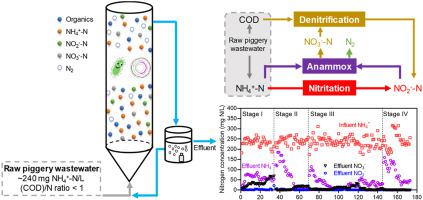Journal of Environmental Management ( IF 8.7 ) Pub Date : 2021-08-02 , DOI: 10.1016/j.jenvman.2021.113431 Pian-Pian Xu 1 , Jia Meng 1 , Xianhui Li 1 , Jiuling Li 2 , Kai Sun 1 , Bing-Feng Liu 1 , Min Zheng 2

|
Nitritation-anammox has been considered to be the most promising process for nitrogen (N) removal from wastewater. However, the anammox reaction still produces an amount of nitrate, which cannot be removed further. This study hypothesizes that heterotrophic denitrification can be an appealing option to remove the residual nitrate in the one-stage nitritation-anammox process. Through monitoring N-removal performance and microbial community succession of a laboratory microaerobic reactor, the effect of four different levels of oxygen supply on nitrate removal was investigated. The reactor was continuously fed with real manure-free piggery wastewater containing ~240 mg NH4+-N/L and chemical oxygen demand (COD)/total nitrogen (TN) ratio of less than 1 for 180 days. With a high influent loading rate of 0.7 kg N/(m3·d), efficient total nitrogen removal (>80 %) was achieved during stable operation of dissolved oxygen (DO) concentrations between 0.3 and 0.6 mg O2/L, indicating N-removal via the nitritation-anammox pathway in the low-carbon wastewater treatment. At the same time, the effluent nitrate reduced with decreased oxygen supply and completely depleted at DO of 0.3 ± 0.1 mg O2/L. In addition to oxygen, preventing ammonia nitrogen from falling to very low levels (<10 mg/L) could be also useful for the complete nitrate removal and stable nitritation-anammox. 16S rRNA gene-based analyses confirmed a complex microbial community including nitrifiers, denitrifiers and anammox bacteria in the biomass of the reactor. Collectively, this study provides new insights into high-level N-removal of a nitritation-anammox process by complete nitrate depletion.
中文翻译:

异养反硝化耦合一阶段亚硝化-厌氧氨氧化完全脱硝研究
亚硝化-厌氧氨氧化被认为是从废水中去除氮 (N) 的最有前途的工艺。然而,厌氧氨氧化反应仍会产生一定量的硝酸盐,无法进一步去除。该研究假设异养反硝化可能是去除一级亚硝化-厌氧氨氧化过程中残留硝酸盐的一种有吸引力的选择。通过监测实验室微好氧反应器的除氮性能和微生物群落演替,研究了四种不同水平的氧气供应对硝酸盐去除的影响。反应器连续注入含有约 240 mg NH 4 + 的真正无粪猪场废水-N/L 和化学需氧量 (COD)/总氮 (TN) 比率小于 1,持续 180 天。在 0.7 kg N/(m 3 ·d)的高进水负载率下,在 0.3 至 0.6 mg O 2 /L 的溶解氧 (DO) 浓度稳定运行期间实现了有效的总氮去除 (>80%) ,表明低碳废水处理中通过亚硝化-厌氧氨氧化途径脱氮。同时,出水硝酸盐随着氧气供应的减少而减少,并在 DO 为 0.3 ± 0.1 mg O 2 时完全耗尽/L。除了氧气,防止氨氮降至非常低的水平 (<10 mg/L) 也可用于完全去除硝酸盐和稳定亚硝化-厌氧氨氧化。基于 16S rRNA 基因的分析证实了一个复杂的微生物群落,包括反应器生物质中的硝化菌、反硝化菌和厌氧氨氧化菌。总的来说,这项研究提供了通过完全耗尽硝酸盐对亚硝化-厌氧氨氧化过程进行高水平脱氮的新见解。



























 京公网安备 11010802027423号
京公网安备 11010802027423号